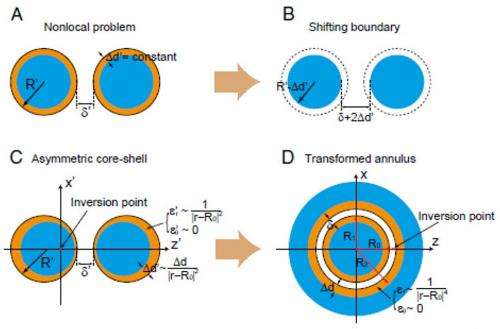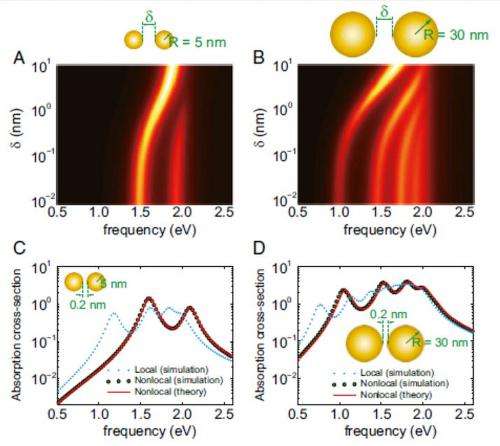January 2, 2015 feature
Nanoscale neighbors: First use of transformation optics to accurately analyze nonlocality in 3D plasmonic systems

(Phys.org) —The ubiquitous van der Waals interaction – a consequence of quantum charge fluctuations – includes intermolecular forces such as attraction and repulsion between atoms, molecules and surfaces. The most long-range force acting between particles, it influences a range of phenomena including surface adhesion, friction and colloid stability. Typically a simple task when parallel surfaces are further apart than 10 nanometers, calculating van der Waals forces between, for example, a pair of nanospheres less than five nanometers apart becomes quite difficult. Moreover, the latter scale requires that the effect of nonlocality (the direct interaction of two objects that are separated in space with no perceivable intermediate agency or mechanism) be considered, introducing complexity into, and thereby further hampering, analysis.
Recently, however, scientists at Imperial College London, London proposed a simple analytic solution, showing – for the first time, the researchers say –that nonlocality in 3D plasmonic systems can be accurately analyzed using transformation optics. (Plasmons are quasiparticles arising from the quantization of plasma oscillations at optical frequencies; by arranging electromagnetic fields in a specific way, transformation optics determines the direction in which electromagnetic radiation will propagate.) The scientists also suggest that their results increase the underlying understanding of nonlocal effects in plasmonic nanostructures.
Prof. Sir John Pendry discussed the paper that he, Dr. Yu Luo and Dr. Rongkuo Zhao published in the Proceedings of the National Academy of Sciences. "Nonlocality introduces computational complexity which makes doing the calculations difficult," Pendry tells Phys.org. "We've found a workaround that greatly simplifies the calculations by replacing the nonlocal system with a local system that reproduces the results to a high degree of accuracy." Specifically, the scientists showed that nonlocality in 3D plasmonic systems can be accurately analyzed using the transformation optics approach – the first time that the technique has been applied to van der Waals forces – which they applied to solve the problem of including nonlocal effects when two nanoscale bodies interact.
"The key to successfully exploiting transformation optics," Pendry points out, "is to choose the right transformation. In our case we were able to transform the problem of two nearly-touching spheres into the much more symmetric problem of two concentric spheres." In so doing, the researchers had to address two challenges:

· the problem involved several length scales, meaning that they had to take into account the spheres themselves (~10nm) as well as the spacing between them, which they tried to push to the limit of one atomic spacing (~0.2nm)
· the fact that the forces depend on contributions from many different frequencies over a range of almost 100eV
Pendry notes that researchers are only now beginning to explore the consequences of nonlocality in nanoscale surface phenomena, and are in the process of building reliable models. "The nanoscale forces in our paper are just one instance of where it's important to treat nonlocality, where the main complication is that the response of a system at a given point depends not just on the electromagnetic fields at that point, but on the fields in the surrounding region as well – a problem that many traditional approaches fail to address."
In their paper, the scientists found that nonlocality dramatically weakens the field enhancement between the spheres, and thereby the van der Waals interaction. "van der Waals forces – although long range relative to standard chemical bonds – are only significant when surfaces are quite close to one another," Pendry explains. "The standard local theory predicts infinite force in the limit that surfaces touch – but of course this is nonsense. Therefore, predictions that make sense and can be compared to experiments need to take nonlocality into account."
Relatedly, the paper states that chemical bonding – while not an explicit concern in this study – will dominate the final approach just before the surfaces touch at a few tenths of a nanometer, at which point direct contact of the charges will come into play through electron tunneling. "The forces we consider are complementary to chemical bonding," Pendry clarifies, "in that the current theoretical approach to chemical bonds exploits the local density approximation. In other words, just as a study of pure van der Waals forces omits chemical bonding, so a pure local density study of bonds has nothing to say about the longer range dispersion forces that we calculate. Of course, at some stage the two have to come together…but for that to happen we need experimental input – and theoretical studies of the van der Waals forces are the first steps in making this happen."
The approach described in the paper makes analytical investigation of 3D nonlocal problems feasible while providing insight into the understanding of nonlocal effects in plasmonic nanostructures. "Calculations are always difficult when treating singular structures – by which we mean situations such as the nearly touching spheres considered in our paper – but also the interaction of needle-sharp points with surfaces," Pendry explains. "Using transformations to unravel the singularity reveals how the forces work in each of these situations, and in fact often enables us to show a common origin." For example, regarding how their results might influence the development of functional subnanometer substrates, he adds that "any nanomechanical system must consider the effects of van der Waals forces – and our paper is an attempt to further our understanding of these problems."
Looking ahead, Pendry tells Phys.org that van der Waals forces are just the first step in a series of investigations the scientists have already planned. "On the near horizon is heat transfer between surfaces that are close but not in physical contact: Electromagnetic fluctuations responsible for the van der Waals force also enable heat to leap across the gap – an effect different from, and much stronger than, radiative cooling." (Radiative cooling is the process by which a body loses heat by thermal radiation.) "In the longer term, we'll try to generalize our theory of quantum friction, whereby surfaces which are close but not in physical contact can experience frictional drag. Nonlocality is also an important issue in the effects."
In closing, Pendry notes that several other areas of research might benefit from their study, given that transformation optics is a very general technique in electromagnetic theory. "The present study is just one in a whole series of applications. We've already seen many studies of its application to invisibility, and we have used it extensively to study intense field enhancements in plasmonic structures, such as surface enhanced Raman spectroscopy. In fact, virtually any problem that has electromagnetic radiation interacting with a physical structure could potentially benefit from transformation optics – and in the case of plasmonic systems, nonlocality will always be an important issue whenever surface in close proximity are considered."
More information: van der Waals interactions at the nanoscale: The effects of nonlocality, Proceedings of the National Academy of Sciences, published online before print December 2, 2014, doi:10.1073/pnas.1420551111
Journal information: Proceedings of the National Academy of Sciences
© 2015 Phys.org


















